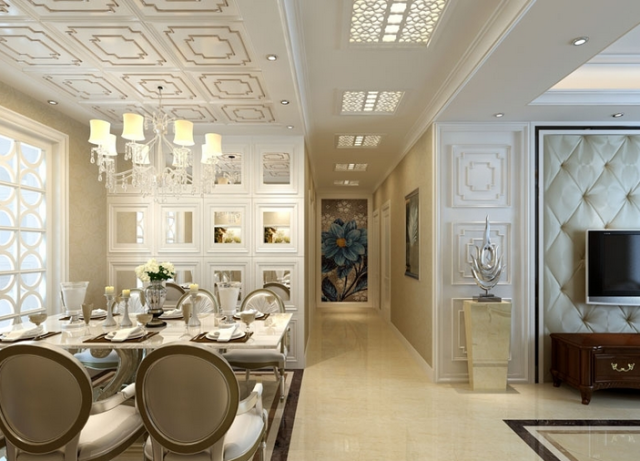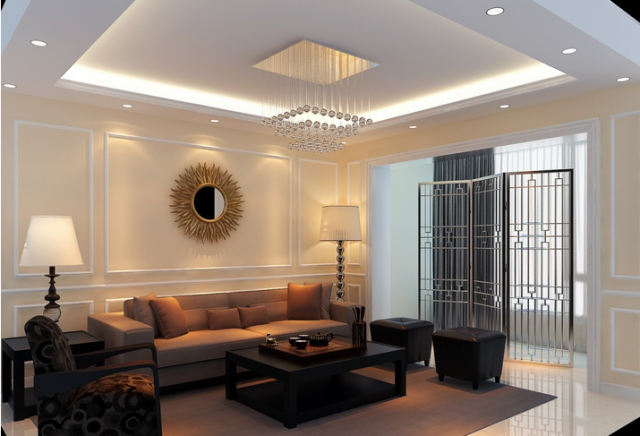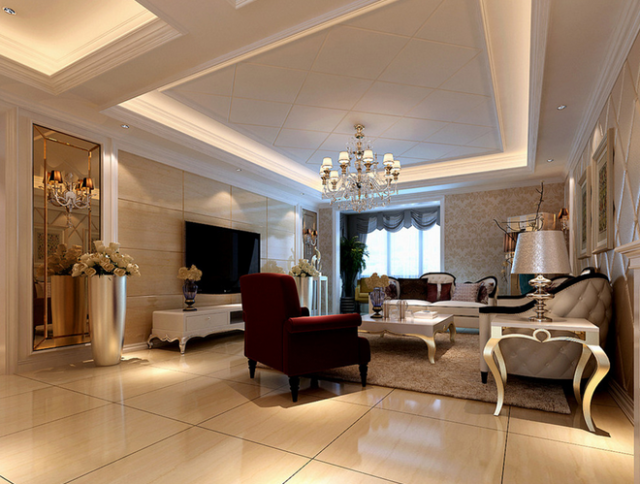 The method of preventing cracking of the ceiling: The construction materials should be carefully selected. 1Selection of ceiling frame materials Select the light steel keel skeleton material strictly according to the design requirements and the national standard light steel. When selecting the keel for wood, note that the moisture content does not exceed the standard. The specification of the keel should be Strict screening should not be too small.
The method of preventing cracking of the ceiling: The construction materials should be carefully selected. 1Selection of ceiling frame materials Select the light steel keel skeleton material strictly according to the design requirements and the national standard light steel. When selecting the keel for wood, note that the moisture content does not exceed the standard. The specification of the keel should be Strict screening should not be too small.  2 Selection of ceiling gypsum plasterboard Currently, there are many types of gypsum board on the market, including general type, waterproof type, fireproof type, and high strength. When designing ceilings, they can be selected according to different usage requirements, different regions and construction seasons. The quality of the gypsum plasterboard in the decoration market is now uneven. The gypsum board with good quality should be used to make the gypsum board with good strength, good toughness, uniform foaming, full molding at the edges, and cracks from the material. problem.
2 Selection of ceiling gypsum plasterboard Currently, there are many types of gypsum board on the market, including general type, waterproof type, fireproof type, and high strength. When designing ceilings, they can be selected according to different usage requirements, different regions and construction seasons. The quality of the gypsum plasterboard in the decoration market is now uneven. The gypsum board with good quality should be used to make the gypsum board with good strength, good toughness, uniform foaming, full molding at the edges, and cracks from the material. problem. In addition, there are generally two types of plasterboard on the market that are 9mm thick and 12mm thick. Many people like to use 9mm thick plain plasterboard to make ceilings, but due to the thinness and low strength of 9mm thick plain plasterboard, it is prone to deformation under wet and humid conditions. It is recommended to use gypsum above 12mm. board. At the same time, the use of thicker plates is also an effective means of preventing joint cracking.
 Method to prevent ceiling cracking: Installation and construction practices should be regulated. 1 Hanger installation specification Hanger spacing should be controlled within 1200mm. As far as possible during construction, the fixed point spacing between booms should be equal. The boom should be as far as possible with gravity. The direction is on the same axis. Where there are obstacles where the boom is not fixed, bridges must be designed to ensure the reasonable spacing between the booms. At the same time, all the ceiling frames and keel plates in the construction must not be connected to flanges and cranes of pipeline equipment. Spaces must be left between the ribs, brackets, etc. to prevent resonance damage.
Method to prevent ceiling cracking: Installation and construction practices should be regulated. 1 Hanger installation specification Hanger spacing should be controlled within 1200mm. As far as possible during construction, the fixed point spacing between booms should be equal. The boom should be as far as possible with gravity. The direction is on the same axis. Where there are obstacles where the boom is not fixed, bridges must be designed to ensure the reasonable spacing between the booms. At the same time, all the ceiling frames and keel plates in the construction must not be connected to flanges and cranes of pipeline equipment. Spaces must be left between the ribs, brackets, etc. to prevent resonance damage.  2 The distance between the main keel of the top of the dragon skeleton installation specification must be controlled within 1000mm, and the distance from the end of the main keel should not be greater than 300mm. When it is greater than 300mm, the boom should be increased. The horizontal laps of the auxiliary keels must be firm and the tops should not be loosened by hand when checking. The clearance between the auxiliary keels must not exceed 2mm. The construction must be carried out strictly according to the drawings and specifications, and the spacing between the keel and the hanging bars must not be arbitrarily increased. The installed skeleton must be in an unstressed state without any imaginary or imaginary hang-ups, and the overall keel frame has a regular level.
2 The distance between the main keel of the top of the dragon skeleton installation specification must be controlled within 1000mm, and the distance from the end of the main keel should not be greater than 300mm. When it is greater than 300mm, the boom should be increased. The horizontal laps of the auxiliary keels must be firm and the tops should not be loosened by hand when checking. The clearance between the auxiliary keels must not exceed 2mm. The construction must be carried out strictly according to the drawings and specifications, and the spacing between the keel and the hanging bars must not be arbitrarily increased. The installed skeleton must be in an unstressed state without any imaginary or imaginary hang-ups, and the overall keel frame has a regular level.  3 Gypsum board installation specification Gypsum board joints need to install cross braces, do not allow the board to hang at the interface. If transverse seams cannot be avoided, the seams should be offset. The horizontal seams of the partition walls should be staggered and cannot lie on the same keel. The strength performance and deformation of gypsum board are determined according to the direction. The longitudinal performance of the board is superior to that of the transverse direction. Therefore, when the ceiling is suspended, the longitudinal direction of the gypsum board is not allowed to be parallel to the surface keel and should be perpendicular to the keel. This prevents deformation and Cracks in the seams are an important measure.
3 Gypsum board installation specification Gypsum board joints need to install cross braces, do not allow the board to hang at the interface. If transverse seams cannot be avoided, the seams should be offset. The horizontal seams of the partition walls should be staggered and cannot lie on the same keel. The strength performance and deformation of gypsum board are determined according to the direction. The longitudinal performance of the board is superior to that of the transverse direction. Therefore, when the ceiling is suspended, the longitudinal direction of the gypsum board is not allowed to be parallel to the surface keel and should be perpendicular to the keel. This prevents deformation and Cracks in the seams are an important measure.  4 Filling putty scraping The specification should leave a 5-8mm gap between the base board and the base board, leaving the gap and chamfering position mainly used to fill enough fine seam putty to make the entire grassroots unite. Caulking should be as late as possible, try to make it dry, and then paste the seam tape. The filler shrinks due to the hardened putty of the filler plate. In order to avoid the dry hard contraction of the putty after filling, there is a dark crack in the seam. The requirement of filling with putty must be carried out in two separate stages. After the second putty is hard, it is pasted with gauze or kraft paper. Only when the net yarn or kraft paper is completely bonded and hardened can the ash be covered. Ps: The phenomenon of cracking in the ceiling is usually caused by the failure of construction materials and the improper installation and construction. So everyone must be looking for ways to find a solution. I hope that Xiaobian can help you by preventing cracks in the ceiling.
4 Filling putty scraping The specification should leave a 5-8mm gap between the base board and the base board, leaving the gap and chamfering position mainly used to fill enough fine seam putty to make the entire grassroots unite. Caulking should be as late as possible, try to make it dry, and then paste the seam tape. The filler shrinks due to the hardened putty of the filler plate. In order to avoid the dry hard contraction of the putty after filling, there is a dark crack in the seam. The requirement of filling with putty must be carried out in two separate stages. After the second putty is hard, it is pasted with gauze or kraft paper. Only when the net yarn or kraft paper is completely bonded and hardened can the ash be covered. Ps: The phenomenon of cracking in the ceiling is usually caused by the failure of construction materials and the improper installation and construction. So everyone must be looking for ways to find a solution. I hope that Xiaobian can help you by preventing cracks in the ceiling. Suspended ceiling
Drywall screws (sometimes called sheetrock screws) provide a stronger hold, but cost a bit more than nails. These usually feature a Phillips head. Coarse drywall screws feature coarse threads to secure gypsum boards to studs. Fine drywall screws feature smaller heads and are used to secure drywall to metal studs..
Drywall screws have deeper threads than regular screws, which prevents them from dislodging easily from the drywall. They are made of steel and require a power screwdriver to drill them into the drywall. ... W-type screws, on the other hand, are longer and thinner. They are designed for installing drywall onto wood.
Fine Thread Drywall Screws,Coarse Thread Standard Screws,Coarse Thread Black Screws,Self Drilling Screw Self Tapping
Yibin Heheng Technology Co.,Ltd , https://www.chinadirectfastening.com
